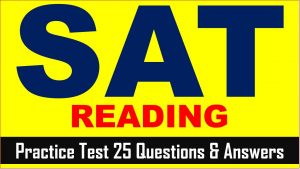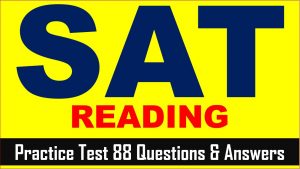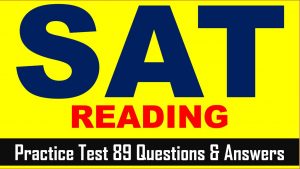SAT (Scholastic Assessment Test) is a standard test, used for taking admission to undergraduate programs of universities or colleges of the United States. SAT is developed and published by the College Board, an organization in the United States, administered by the Educational Testing Service. In this article of AKVTutorials, you will get SAT Reading and Writing Prep Test 48 | SAT 2024 Online Tutor AMBiPi.
SAT Reading Practice Passage
This passage is adapted from Sabrina Richards, “Pleasant to the Touch.” ©2012 by The Scientist.
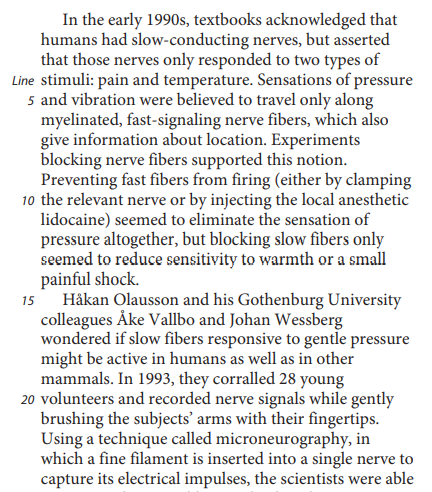
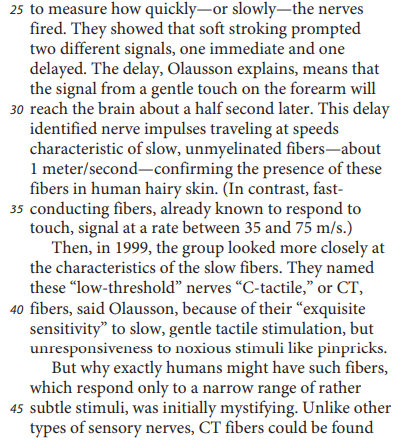
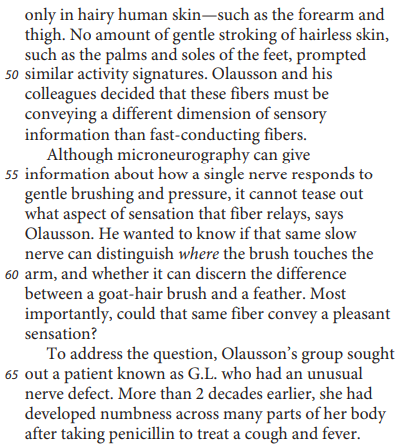
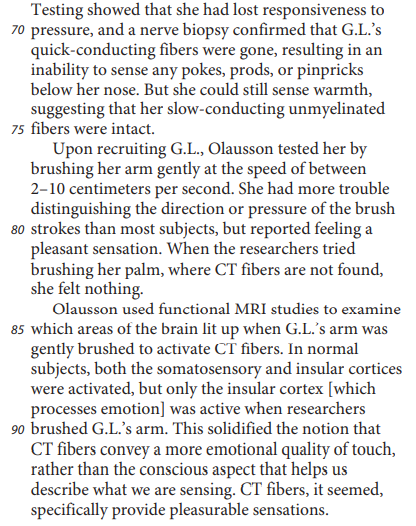
SAT Reading Comprehension Practice Test Questions
SAT Practice Test 48 Question No 1
Based on the passage, textbook authors in the early 1990s would most likely have expected which condition to result from the blocking of fast fibers?
Option A: The rate at which other nerve fibers fired would increase.
Option B: The test subject would perceive gentle stimuli as painful.
Option C: The body would compensate by using slow fibers to sense pressure.
Option D: The ability to perceive vibrations would be impaired.
SAT Practice Test 48 Answer No 1
Show/Hide Answer
Option D :
The first paragraph asserts that textbook authors in the early 1990s believed that “sensations of pressure and vibration . . . travel only along myelinated, fast-signaling nerve fibers.” Thus, based on the passage, textbook authors in the early 1990s would most likely have expected that the ability to perceive vibrations would be impaired as a result of blocking fast fibers.
Choices A, B, and C are incorrect because the passage indicates that textbook authors in the early 1990s believed blocking fast nerve fibers would impair sensations of vibration, not that blocking would increase the firing rate of other fibers (choice A), cause gentle stimuli to be perceived as painful (choice B), or make the body compensate by using slow fibers to sense pressure (choice C).
SAT Practice Test 48 Question No 2
Which choice provides the best evidence for the answer to the previous question?
Option A: Lines 1-4 (“In the… temperature”)
Option B: Lines 4-7 (“Sensations… location”)
Option C: Lines 12-14 (“blocking… shock”)
Option D: Lines 34-36 (“In contrast…75 m/s”)
SAT Practice Test 48 Answer No 2
Show/Hide Answer
Option B :
The previous question asks what condition textbook authors in the early 1990s would most likely have expected to result from blocking fast fibers. The answer, that they would most likely have expected blocking fast fibers to result in an impairment of the ability to perceive vibrations is best supported in the first paragraph, which refers to the views of textbook authors in the early 1990s: “Sensations of pressure and vibration were believed to travel only along myelinated, fast-signaling nerve fibers, which also give information about the location.”
Choices A, C, and D are incorrect because the cited lines don’t provide the best evidence for the answer to the previous question. Instead, they assert that textbook authors in the early 1990s believed slow-conducting nerves responded only to pain and temperature stimuli (choice A), noted that blocking slow fibers only seemed to reduce sensitivity to warmth or small painful shocks (choice C), and knew that fast-conducting fibers responded to touch at a signal rate of 35 to 75 m/s (choice D).
SAT Practice Test 48 Question No 3
As used in line 18, “active” most nearly means
Option A: present.
Option B: attentive.
Option C: movable.
Option D: restless.
SAT Practice Test 48 Answer No 3
Show/Hide Answer
Option A :
The second paragraph states, “Håkan Olausson and his Gothenburg University colleagues Åke Vallbo and Johan Wessberg wondered if slow fibers responsive to gentle pressure might be active in humans as well as in other mammals.” In other words, the researchers wondered if these nerves were present, or existent, in humans and other mammals. Therefore, in the context of the passage, the word “active” most nearly means present.
Choices B, C, and D are incorrect because in the context of the passage, “active” most nearly means present, not attentive (choice B), movable (choice C), or restless (choice D).
SAT Practice Test 48 Question No 4
As used in line 24, “capture” most nearly means
Option A: occupy.
Option B: seize.
Option C: record.
Option D: influence.
SAT Practice Test 48 Answer No 4
Show/Hide Answer
Option C :
The second paragraph states, “Using a technique called microneurography, in which a fine filament is inserted into a single nerve to capture its electrical impulses, the scientists were able to measure how quickly—or slowly—the nerves fired.” In other words, the researchers used the technique known as microneurography to record, or register, the electrical signals sent by nerve fibers. Therefore, in the context of the passage, the word “capture” most nearly means record.
Choices A, B, and D are incorrect because in the context of the passage, “capture” most nearly means record, not occupy (choice A), seize (choice B), or influence (choice D).
SAT Practice Test 48 Question No 5
Which conclusion is best supported by the findings of Olausson’s 1993 experiment?
Option A: Stimulation at bodily extremities can be sensed as rapidly as stimulation closer to the brain.
Option B: The presence of hairs in human skin lessens the speed with which nerves conduct signals.
Option C: Gentle pressure is sensed not only by fast fibers but also by slow fibers.
Option D: The speed at which a nerve fires is dependent on the strength of pressure applied to the nerve.
SAT Practice Test 48 Answer No 5
Show/Hide Answer
Option C :
According to the passage, different types of nerve fibers carry signals at different speeds, either fast or slow. The second paragraph outlines a study led by Håkan Olausson in 1993 that measured the response time of nerves when exposed to gentle pressure. Olausson and his team found that “soft stroking prompted two different signals” in test subjects’ nerve fibers, “one immediate and one delayed.” Therefore, the conclusion that is best supported by the findings of Olausson’s 1993 experiment is that gentle pressure is sensed not only by fast fibers but also by slow fibers.
Choices A and D are incorrect because according to the passage, Olausson’s 1993 study didn’t compare how signal speed was affected by stimulation in different bodily areas (choice A) or by different amounts of pressure applied to the nerve (choice D). Choice B is incorrect because the passage notes that only human hairy skin contains slow nerve fibers, not that hair causes signal speeds to slow.
SAT Practice Test 48 Question No 6
Which choice provides the best evidence for the answer to the previous question?
Option A: Lines 22-26 (“Using… fired”)
Option B: Lines 26-28 (“They… delayed”)
Option C: Lines 28-30 (“The delay… later”)
Option D: Lines 37-38 (“Then… fibers”)
SAT Practice Test 48 Answer No 6
Show/Hide Answer
Option B :
The previous question asks which conclusion is best supported by the findings of Olausson’s 1993 experiment. The answer, that Olausson’s 1993 experiment best supports the conclusion that gentle pressure is sensed not only by fast fibers but also by slow fibers, is best supported in the second paragraph: Olausson’s team “showed that soft stroking prompted two different signals, one immediate and one delayed.”
Choices A, C, and D are incorrect because the cited lines don’t provide the best evidence for the answer to the previous question. Instead, they describe a technique used by Olausson’s team (choice A), quantify the amount of time between the fast signals and the slow signals observed by Olausson’s team (choice C), and introduce a further study conducted by Olausson’s team in 1999 (choice D).
SAT Practice Test 48 Question No 7
The sentence in lines 43-45 (“But… mystifying”) serves mainly to
Option A: identify factors that Olausson had previously failed to consider.
Option B: propose a solution to a dilemma encountered by Olausson.
Option C: anticipate a potential criticism of Olausson by the reader.
Option D: show a problem from the perspective of Olausson’s team.
SAT Practice Test 48 Answer No 7
Show/Hide Answer
Option D :
This sentence from the fourth paragraph outlines a quandary that arose from the 1999 study conducted by Olausson’s team: “But why exactly humans might have such fibers, which respond only to a narrow range of rather subtle stimuli, was initially mystifying.” The passage presents this line of inquiry as a justification for the team’s subsequent research on CT fibers. Thus this sentence serves mainly to show a problem from the perspective of Olausson’s team.
Choices A, B, and C are incorrect. The cited lines serve mainly to show a problem from the perspective of Olausson’s team, not to identify factors Olausson had previously failed to consider (choice A), propose a solution to a dilemma encountered by Olausson (choice B), or anticipate a potential criticism of Olausson by the reader (choice C).
SAT Practice Test 48 Question No 8
It can reasonably be inferred that one of the intended goals of the 1999 experiment was to determine the
Option A: precise nature of sensations that CT fibers can convey.
Option B: relationship between body hair and CT fiber function.
Option C: role played by CT fibers in the perception of pain.
Option D: effect of microneurography on CT fiber signaling.
SAT Practice Test 48 Answer No 8
Show/Hide Answer
Option A :
According to the fifth paragraph, Olausson set out to discover, in his team’s 1999 research, whether a CT nerve “can distinguish where the brush touches the arm, and whether it can discern the difference between a goat-hair brush and a feather. Most importantly, could that same fiber convey a pleasant sensation?” Therefore, it can reasonably be inferred that one of the intended goals of the 1999 experiment was to determine the precise nature of sensations that CT fibers can convey.
Choices B, C, and D are incorrect because in their 1999 research, Olausson’s team didn’t seek to determine the relationship between human body hair and CT fiber function (choice B), the role played by CT fibers in the perception of pain (choice C), or the effects of microneurography on CT fiber signaling (choice D).
SAT Practice Test 48 Question No 9
The main purpose of the sixth paragraph (lines 64-75) is to
Option A: identify those of G.L.’s neurological conditions that might be relieved by the experiment.
Option B: contextualize the nerve function of G.L. by comparing it with that of other adults.
Option C: detail procedures that G.L. had experienced during previous experiments.
Option D: indicate why G.L.’s medical condition was of value to Olausson’s experiment.
SAT Practice Test 48 Answer No 9
Show/Hide Answer
Option D :
In the 1999 study, Olausson’s team conducted experiments on a patient known as G.L. The researchers wanted to learn more about what type of sensations slow-conducting CT nerve fibers transmit, and G.L. was of special interest to them, according to the sixth paragraph: “More than 2 decades earlier . . . she had lost responsiveness to pressure, and a nerve biopsy confirmed that G.L.’s quick-conducting fibers were gone. . . . But she could still sense warmth, suggesting that her slow-conducting unmyelinated fibers were intact.” The fact that G.L.’s slow-conducting fibers were still intact while her other nerves were unresponsive allowed Olausson’s team to study her slow-conducting CT fibers in isolation. Thus the main purpose of the sixth paragraph is to indicate why G.L.’s medical condition was of value to Olausson’s experiment.
Choices A, B, and C are incorrect because the sixth paragraph doesn’t indicate that Olausson’s team set out to relieve any of the neurological conditions that G.L. exhibited (choice A), compare G.L.’s nerve function with that of other adults (choice B), or detail any procedures that G.L. had experienced during previous experiments (choice C).
SAT Practice Test 48 Question No 10
According to the passage, G.L. differed from Olausson’s other test subjects in terms of the
Option A: number of cortices activated in the brain during gentle brushing.
Option B: physical dimensions of the somatosensory cortex.
Option C: intensity of nerve signals required to activate the insular cortex.
Option D: effect of MRI scanning on the basic function of brain cortices.
SAT Practice Test 48 Answer No 10
Show/Hide Answer
Option A :
According to the last paragraph, “in normal subjects, both the somatosensory and insular cortices were activated [by gentle brushing], but only the insular cortex [which processes emotion] was active when researchers brushed G.L.’s arm.” Therefore, according to the passage, G.L. differed from Olausson’s other test subjects in terms of the number of cortices activated in the brain during gentle brushing.
Choice B is incorrect because the passage doesn’t address the physical dimensions of the somatosensory cortex in G.L. or other test subjects. Choice C is incorrect because G.L. differed from other test subjects in terms of the number of cortices activated in the brain during gentle brushing, not in terms of the intensity of nerve signals required to activate the insular cortex. Choice D is incorrect because MRI scanning is discussed in the passage as a method used to locate brain activity, not as a focus of study in Olausson’s research.

